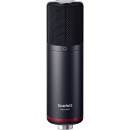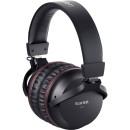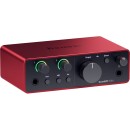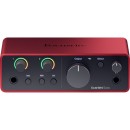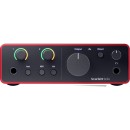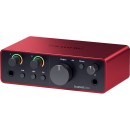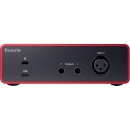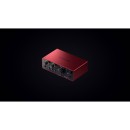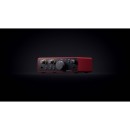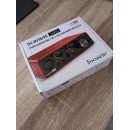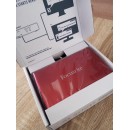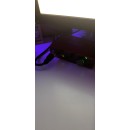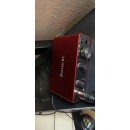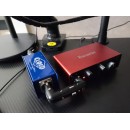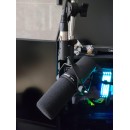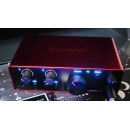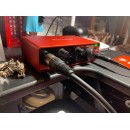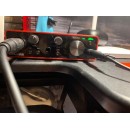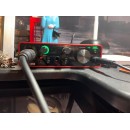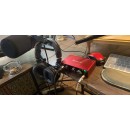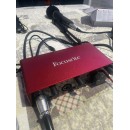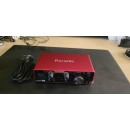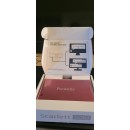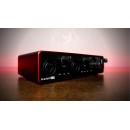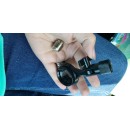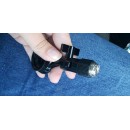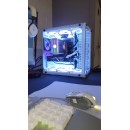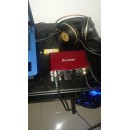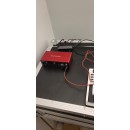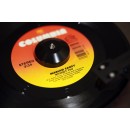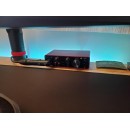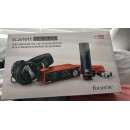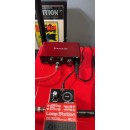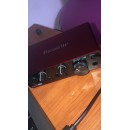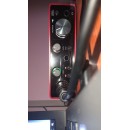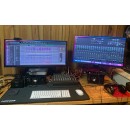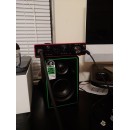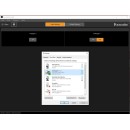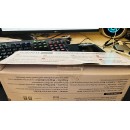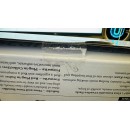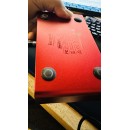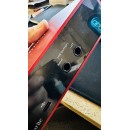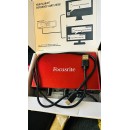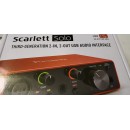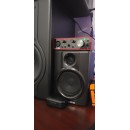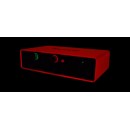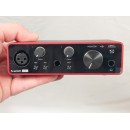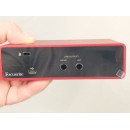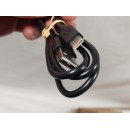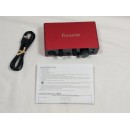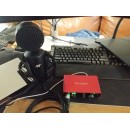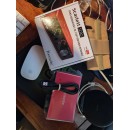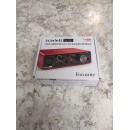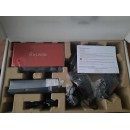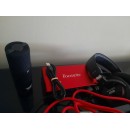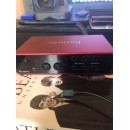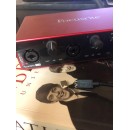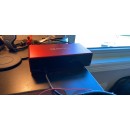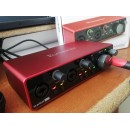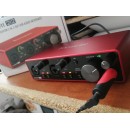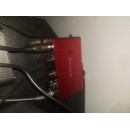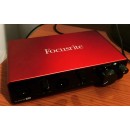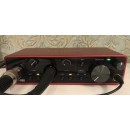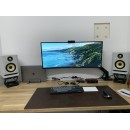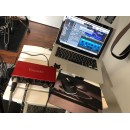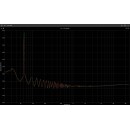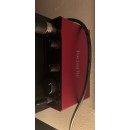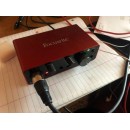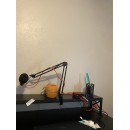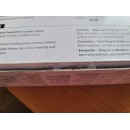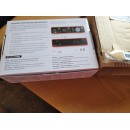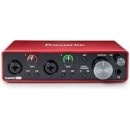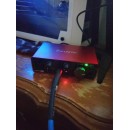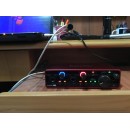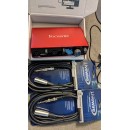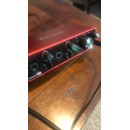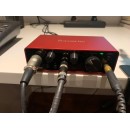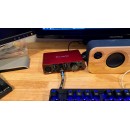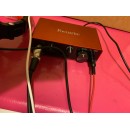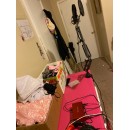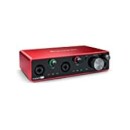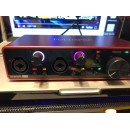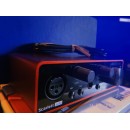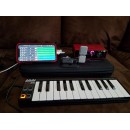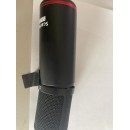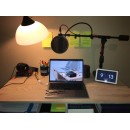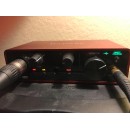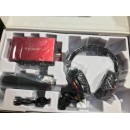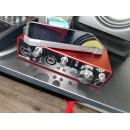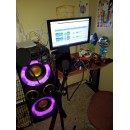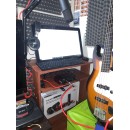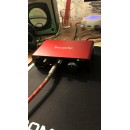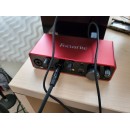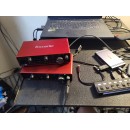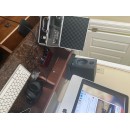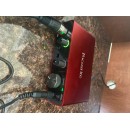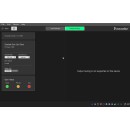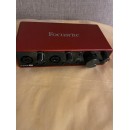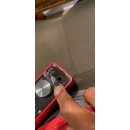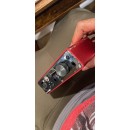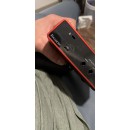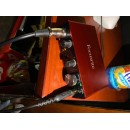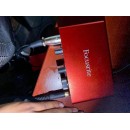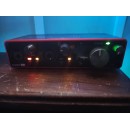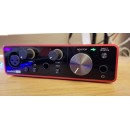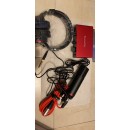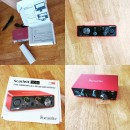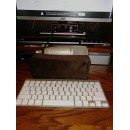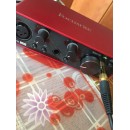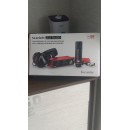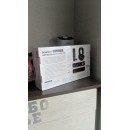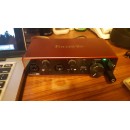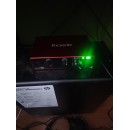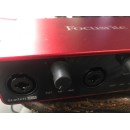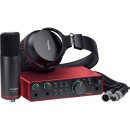Focusrite Scarlett Solo Studio USB-C Audio Interface (4th Gen) Review
- Ultra-low latency for seamless performance
- High-performance 24-bit/192kHz converters
- Upgraded Scarlett mic preamp with Air mode
- XLR microphone input and high-headroom instrument input
- Studio-quality condenser microphone included
- Closed-back headphones for accurate monitoring
- USB-C connectivity for fast, reliable connection
- Included software bundle with DAW and plugins
- Compact and rugged design for portability
- Easy-to-use interface with gain halos for visual feedback
Product Specifications and Detailed Analysis
The Focusrite Scarlett Solo Studio USB-C Audio Interface with Microphone and Headphones (4th Generation) is an all-in-one recording package designed for musicians, podcasters, and content creators seeking professional-quality audio. This bundle includes the Scarlett Solo USB-C audio interface, a CM25 MkIII condenser microphone, and a pair of HP60 MkIII closed-back headphones.
The Scarlett Solo interface features a single mic preamp, known for its high-quality sound and low latency, as well as an instrument input for direct recording of guitars and other instruments. The USB-C connectivity ensures fast and reliable data transfer, making it compatible with both Mac and PC systems. Additionally, the interface includes intuitive controls and LED indicators, allowing users to easily monitor their input levels and adjust settings on the fly.
Paired with the CM25 MkIII condenser microphone, users can capture clear and detailed vocals or acoustic instruments. The HP60 MkIII headphones provide accurate monitoring with excellent isolation, ensuring that you hear every nuance of your recordings. Together, these components make the Scarlett Solo Studio a versatile and user-friendly solution for high-quality home recording.
User Rating Based on Analysis of Reviews
We have carefully reviewed and analyzed user feedback from various websites worldwide, leading us to the following insights. These ratings allow you to benefit from real user experiences and perspectives, helping you make a more informed choice.
Purchase Value
85% of users expressed satisfaction with the purchase value of the Focusrite Scarlett Solo Studio USB-C Audio Interface. Many praised the product for providing a comprehensive studio package at an affordable price, making it an ideal choice for beginners and hobbyists. Users appreciated the quality of the bundled microphone and headphones, which they felt exceeded their expectations for the price point.
15% of users were dissatisfied with the purchase value, citing that although the package was affordable, they felt individual components could be of higher quality. Some users mentioned that they experienced issues with the durability of the headphones, leading them to question the overall long-term value.
Quality of Materials
80% of users were content with the quality of materials used in the Focusrite Scarlett Solo Studio. They highlighted the robust build of the audio interface, noting that it felt sturdy and well-constructed. Many users appreciated the sleek design and durable knobs, which contributed to a professional feel.
20% of users were dissatisfied with the quality of materials, with complaints primarily focused on the headphones. Some users reported that the headphones felt flimsy and uncomfortable during extended use. Additionally, a few users noted issues with the microphone's build quality, expressing concerns about its longevity.
Ease of Setup
90% of users were pleased with the ease of setup for the Focusrite Scarlett Solo Studio. Many praised the straightforward installation process and user-friendly software, which allowed them to start recording quickly without any technical difficulties. The clear instructions provided were also noted as a major plus.
10% of users faced challenges with the setup process. These users reported difficulties in installing the necessary drivers and software compatibility issues with certain operating systems. Some also found the initial configuration of the interface somewhat confusing without prior experience.
Sound Quality
88% of users were highly satisfied with the sound quality delivered by the Focusrite Scarlett Solo Studio. They appreciated the clear and detailed audio capture from the microphone and the crisp playback from the headphones. Many users stated that the interface provided a noticeable improvement over their previous setups.
12% of users were not fully satisfied with the sound quality. Some mentioned experiencing occasional audio dropouts and latency issues, particularly when using third-party software. A few users also remarked that while the sound quality was good, it didn't quite match their expectations based on the product's marketing.
Durability
75% of users felt that the Focusrite Scarlett Solo Studio was a durable product. They were particularly impressed with the audio interface's build, which appeared to withstand regular use without any noticeable wear and tear. Users noted that the solid construction gave them confidence in the product's longevity.
25% of users expressed concerns about the durability of the product. The most common complaints were about the longevity of the headphones and occasional issues with cable connections. A few users reported that the microphone showed signs of wear after only a few months of use.
Portability
82% of users appreciated the portability of the Focusrite Scarlett Solo Studio. They found the compact size of the audio interface and the light weight of the components ideal for mobile setups and small home studios. Many noted that the package was easy to transport and set up in different locations.
18% of users found the portability lacking. Some users encountered difficulties with cable management during transport, leading to tangling and potential damage. A few also indicated that the headphones were not as travel-friendly due to their design, which made them less compact compared to other models.
Compatibility
86% of users were satisfied with the compatibility of the Focusrite Scarlett Solo Studio with various operating systems and DAWs. They lauded the seamless integration with popular software and the minimal configuration required to operate efficiently across different platforms.
14% of users experienced compatibility issues. Some users faced challenges with driver installations on older operating systems and noted a lack of support for certain niche DAWs. These issues occasionally resulted in limited functionality or additional troubleshooting steps.
Customer Support
78% of users were pleased with the customer support provided by Focusrite. Many reported quick response times and effective solutions to their queries, which contributed to a positive post-purchase experience. The availability of comprehensive online resources was also a noted advantage.
22% of users were dissatisfied with customer support. They cited slow response times and insufficient assistance for more complex issues. Some users felt that the support team was not as knowledgeable about the product as expected, which led to unresolved concerns.
Design
87% of users praised the design of the Focusrite Scarlett Solo Studio, appreciating its sleek and modern aesthetic. The intuitive layout of controls on the audio interface was well-received, with users finding it easy to navigate and operate.
13% of users were not completely satisfied with the design. Some found the headphone design to be somewhat outdated and not as comfortable as they had hoped. A few users also noted that the interface's layout, while intuitive, was not as innovative as they expected.
Bundled Software
84% of users were satisfied with the bundled software that comes with the Focusrite Scarlett Solo Studio. They valued the inclusion of useful plugins and DAWs, which enhanced their recording capabilities and provided a good starting point for beginners.
16% of users found the bundled software lacking. Some users felt that the software offerings were limited and not as versatile as they would have liked for more advanced projects. A few users also experienced difficulties with software activation and updates.
Microphone Quality
85% of users were satisfied with the microphone quality provided in the Focusrite Scarlett Solo Studio. They noted the clear and accurate sound reproduction, which was suitable for a variety of recording applications, from vocals to instruments.
15% of users were not entirely satisfied with the microphone quality. Some users reported issues with background noise and sensitivity levels, which affected their recordings. A few also mentioned that the microphone's performance was inconsistent in different acoustic environments.
Headphone Quality
78% of users were content with the headphone quality in the Focusrite Scarlett Solo Studio. They appreciated the clear sound and comfortable fit for short recording sessions, noting that the headphones were adequate for monitoring purposes.
22% of users expressed dissatisfaction with the headphone quality. Complaints centered around comfort during extended use and the headphones' limited frequency response, which did not meet the expectations of users with prior professional experience.
Latency
82% of users were satisfied with the low latency performance of the Focusrite Scarlett Solo Studio. They reported minimal delay during recording and monitoring, which enhanced their workflow and allowed for a more seamless recording experience.
18% of users experienced latency issues. Some reported noticeable delays when using certain DAWs or plugins, which disrupted their recording sessions. A few users mentioned that resolving these latency problems required additional adjustments and settings changes.
Aesthetics
88% of users appreciated the aesthetics of the Focusrite Scarlett Solo Studio, noting its modern and visually appealing design. The red aluminum casing of the audio interface was particularly well-liked, with users finding it both stylish and professional.
12% of users were less impressed with the aesthetics. Some found the design to be too minimalistic, wishing for more distinctive features. A few also commented that the headphones' appearance did not match the sleek design of the interface, detracting from the overall visual appeal.
Instruction Manual
80% of users found the instruction manual helpful and easy to understand. They appreciated the clear guidance provided, which helped them navigate the setup and operation of the Focusrite Scarlett Solo Studio without needing additional assistance.
20% of users were dissatisfied with the instruction manual. Some found it lacking in detail, particularly for more advanced features or troubleshooting steps. A few users mentioned that the manual did not adequately address certain common issues, leaving them to seek help elsewhere.
Connectivity Options
83% of users were pleased with the connectivity options available on the Focusrite Scarlett Solo Studio. They appreciated the USB-C interface for its speed and reliability, as well as the various input and output options that allowed for flexible setups.
17% of users found the connectivity options insufficient. Some users desired more input channels for greater versatility in their recording setups. A few also mentioned occasional connectivity issues with certain computers, which required additional adapters or troubleshooting.
User Interface
89% of users were very satisfied with the user interface of the Focusrite Scarlett Solo Studio. They highlighted the intuitive design and ease of navigation, which made it simple to adjust settings and achieve desired audio results quickly.
11% of users found the user interface lacking. Some mentioned that while it was generally user-friendly, certain adjustments required more steps than anticipated, leading to a slight learning curve. A few users also expressed a desire for more advanced customization options.
Brand Reputation
91% of users expressed trust and satisfaction with the brand reputation of Focusrite. They valued the company's history of producing reliable audio equipment and felt confident in their purchase due to positive past experiences or recommendations.
9% of users were less impressed with the brand reputation. Some mentioned previous issues with other Focusrite products that affected their confidence. A few users also felt that the brand did not live up to its reputation in terms of innovation and customer service.
Overall Satisfaction
84% of users reported overall satisfaction with the Focusrite Scarlett Solo Studio. They found it to be a well-rounded package that met their recording needs, offering good sound quality, ease of use, and a solid build at a competitive price.
16% of users were not fully satisfied overall. Some users believed the product did not meet their specific professional requirements or had higher expectations based on reviews. A few also noted minor issues that, when combined, affected their overall experience.
In the following sections, we will dive deep into the specifications, advantages, and disadvantages of the Focusrite Scarlett Solo Studio USB-C Audio Interface with Microphone and Headphones (4th Generation). This comprehensive review aims to provide you with all the necessary information to make an informed decision about this product.
Pros:
- High-quality microphone and headphones included, making it a comprehensive starter kit.
- USB-C connectivity ensures fast and reliable data transfer.
- Compact and portable design, ideal for mobile setups.
- High-resolution audio recording up to 24-bit/192kHz.
- Easy to use with a simplified control interface.
Cons:
- Limited to only one XLR input, which may not be suitable for multi-microphone setups.
- No MIDI input/output for connecting MIDI controllers or instruments.
- Headphones and microphone quality may not meet professional studio standards.
- Requires software installation, which could be cumbersome for some users.
- Pricier compared to other entry-level audio interfaces without bundled accessories.
General
| Channels of I/O | Analog: 2 Inputs / 2 Outputs at 192 kHz |
|---|---|
| Built-In DSP | |
| Maximum Sampling Rate | 192 kHz / 24-Bit |
| Number of Microphone Inputs | 1 |
| Built-In Microphone | |
| Input Level Adjustment | 2x Knob |
| Expansion Slots |
The specifications of the Focusrite Scarlett Solo Studio USB-C Audio Interface highlight the device's capabilities and features designed for optimal audio recording and playback. Show More
Channels of I/O: This specification indicates the number of input and output channels available for audio signal processing. The Scarlett Solo offers 2 inputs and 2 outputs, which means you can connect multiple audio sources or instruments simultaneously, providing flexibility for recording sessions. Operating at a high sampling rate of 192 kHz ensures high fidelity in audio quality, which is essential for professional recordings.
Built-In DSP: This feature refers to whether the audio interface includes Digital Signal Processing capabilities. In this case, the Scarlett Solo does not have built-in DSP. While this may limit certain real-time processing effects directly on the interface, it allows for a more straightforward signal path, which can be beneficial for those who prefer to manage effects through software.
Maximum Sampling Rate: The maximum sampling rate of 192 kHz and a bit depth of 24-bit signify the highest quality of audio capture and playback. Higher sampling rates and bit depths provide more detail in the audio signal, allowing for richer sound and more accurate representation of the original audio, which is particularly important for professional audio production.
Number of Microphone Inputs: The Scarlett Solo features one microphone input. This is ideal for solo artists or podcasters who require a single microphone for recording. Having a dedicated microphone input with high-quality preamps ensures that vocals and other acoustic instruments are captured with clarity and warmth.
Built-In Microphone: The absence of a built-in microphone means that users need to connect an external microphone to record audio. This design choice caters to those who prefer using their preferred microphones for specific recording needs, allowing for greater customization and quality control.
Input Level Adjustment: The Scarlett Solo includes a 2x knob for input level adjustment, allowing users to easily control the gain for the connected audio sources. This feature is crucial for preventing distortion and ensuring that recordings maintain a clean sound, providing a balance between sensitivity and headroom.
Expansion Slots: The lack of expansion slots indicates that the Scarlett Solo does not support additional hardware upgrades or modules. While this may limit future expandability, it simplifies the design and operation, making it a straightforward choice for users who need a reliable, all-in-one recording solution without the need for additional components.
Signal Processing
| Gain/Trim Range | Mic/Line Inputs: Up to +69 dB Hi-Z Inputs: 62 dB |
|---|
The Gain/Trim Range is a crucial specification that indicates the level of amplification available for both microphone and instrument inputs. For the mic/line inputs, a gain range of up to +69 dB allows users to capture quiet sounds clearly, making it ideal for vocals and acoustic instruments that require more sensitivity. This high gain ensures that even subtle nuances in performance are picked up without introducing noise or distortion.Show More
For Hi-Z (high impedance) inputs, which are typically used for electric guitars and other instruments, a gain of 62 dB is provided. This level of gain is sufficient for amplifying the signal from high-impedance sources effectively, ensuring that the audio retains its character and clarity. The ability to adjust gain settings is essential for achieving the right balance in audio recording, allowing for flexibility across various types of sound sources and recording environments.
Connectivity
| Analog Audio I/O | 1x XLR 3-Pin Balanced Mic Input 1x 1/4" TS Unbalanced Line/Hi-Z Input (Front Panel) 2x 1/4" TRS Balanced Monitor Output 1x 1/4" TRS Headphone Output (Front Panel) |
|---|---|
| Phantom Power | 48 V, Selectable On/Off |
| Digital Audio I/O | |
| Host Connection | 1x USB-C |
| Host Connection Protocol | USB 2.0 |
| USB (Non-Host) | |
| Sync I/O | |
| Network I/O | |
| MIDI I/O | |
| Wireless |
The Analog Audio I/O specifications detail the various input and output options available on the Focusrite Scarlett Solo Studio. The setup includes one XLR 3-pin balanced mic input, which is ideal for connecting professional microphones, ensuring high-quality audio capture. Additionally, there is a 1/4" TS unbalanced line/Hi-Z input located on the front panel, allowing for direct connections from instruments such as electric guitars or keyboards. The device also features two 1/4" TRS balanced monitor outputs for connecting studio monitors, enabling accurate audio playback. For personal monitoring, a 1/4" TRS headphone output is included, providing a convenient way to listen to recordings or mixes in real-time.Show More
The Phantom Power option at 48 V is particularly useful for users employing condenser microphones, which require external power to function. The selectable on/off feature allows users to activate phantom power only when necessary, helping to preserve battery life and prevent damage to dynamic microphones that do not require this type of power.
In terms of Digital Audio I/O, the Scarlett Solo does not include any digital input or output options, focusing instead on analog connections for straightforward use. The Host Connection is facilitated via a single USB-C port, which ensures compatibility with modern computers and devices while offering fast data transfer rates through the USB 2.0 protocol. This efficient connection method enhances the overall user experience by simplifying setup and ensuring reliable performance.
The device lacks features like Sync I/O, Network I/O, MIDI I/O, and Wireless connectivity options, making it a straightforward tool for musicians and podcasters who require essential audio functionality without the complexity of additional networking or synchronization features. This simplicity can be beneficial for those who prioritize ease of use and direct audio processing.
Performance
| Frequency Response | XLR Mic Inputs: 20 Hz to 20 kHz ±0.06 dB 1/4" Line Inputs: 20 Hz to 20 kHz 0.05 dB 1/4" Hi-Z Inputs: 20 Hz to 20 kHz 0.15 dB |
|---|---|
| Maximum Input Level | XLR Mic: 9.5 dBu 1/4" Line: 22 dBu 1/4" Hi-Z: 12 dBu |
| Maximum Output Level | 1/4" Line: +16 dBu |
| Headphone Output Power | 1/4": 32 mW into 33 Ohms 22 mW into 300 Ohms |
| Impedance | XLR Mic Inputs: 3 Kilohms 1/4" Line Inputs: 60 Kilohms 1/4" Hi-Z Inputs: 1 Megohms 1/4" Line Outputs: 200 Ohms 1/4" Headphone Outputs: < 50 Ohm |
| Dynamic Range | XLR Mic Inputs: 113 dBA 1/4" Line Inputs: 113 dBA 1/4" Hi-Z Inputs: 112 dBA 1/4" Line Outputs: 120 dB 1/4" Headphone: 112 dB (at 33 Ohms) 115 dB (at 300 Ohms) Digital A/D Converters: 120 dB Digital D/A Converters: 130 dBA |
| THD+N | XLR Mic Inputs: -100 dB (at Minimum Gain) 1/4" Line Inputs: -100 dB (at 8 dB Gain) 1/4" Hi-Z Inputs: -80 dB (at Minimum Gain) 1/4" Line Outputs: -100 dB (at Minimum Gain) 1/4" Headphone Outputs: -97 dB (at 33 Ohms) -102 dB (at 300 Ohms) Digital A/D Converters: -110 dB Digital D/A Converters: -115 dB |
| EIN | XLR Mic Inputs: -127 dBu A-Weighted |
The specifications of the Focusrite Scarlett Solo Studio USB-C Audio Interface highlight its capabilities and performance for audio recording and playback. Show More
Frequency Response indicates the range of frequencies that the audio interface can handle effectively. For the XLR Mic Inputs, a frequency response of 20 Hz to 20 kHz ±0.06 dB ensures that the microphone captures the full spectrum of human hearing without significant loss or distortion. The same response applies to the 1/4" Line Inputs, while the Hi-Z Inputs exhibit a slightly wider tolerance. A flat frequency response across these inputs ensures accurate sound reproduction, making it suitable for professional audio applications.
Maximum Input Level refers to the highest signal strength that the inputs can handle before distortion occurs. With values such as 9.5 dBu for XLR Mic inputs and 22 dBu for 1/4" Line inputs, this feature allows the interface to accommodate various sound sources, from quiet signals like vocals to louder instruments like electric guitars, without compromising audio quality.
Maximum Output Level indicates how strong a signal can be sent out from the audio interface. A maximum output level of +16 dBu for the 1/4" Line outputs means that the device can provide a robust signal to connected devices, ensuring that recordings or mixes maintain clarity and presence.
Headphone Output Power is crucial for monitoring audio while recording or mixing. The Scarlett Solo provides 32 mW into 33 Ohms and 22 mW into 300 Ohms, which allows for flexibility in headphone choice, delivering sufficient power to drive various headphone types effectively.
Impedance is vital for matching audio components. The XLR Mic Inputs have an impedance of 3 Kilohms, which is suitable for most microphones, while the Hi-Z Inputs feature a higher impedance of 1 Megohm, making them ideal for high-impedance instruments like electric guitars. Lower output impedance (200 Ohms for Line Outputs) ensures compatibility with a wide range of devices.
Dynamic Range measures the range between the quietest and loudest sounds the interface can handle without distortion. With a dynamic range of 113 dBA for both XLR Mic and 1/4" Line Inputs, the Scarlett Solo captures subtle nuances in audio, making it great for detailed recordings. The higher the dynamic range, the better the interface can manage varying audio levels.
THD+N stands for Total Harmonic Distortion plus Noise, indicating the level of unwanted distortion in audio signals. Values like -100 dB for XLR Mic Inputs at minimum gain show that the interface maintains a clean signal, free from significant interference.
Finally, EIN (Equivalent Input Noise) is a measure of the noise floor of the microphone inputs. An EIN of -127 dBu A-Weighted means that the interface produces very low background noise, which is essential for high-quality recordings, especially in quiet environments.
These specifications collectively ensure that the Focusrite Scarlett Solo Studio delivers professional-grade audio quality for recording, mixing, and playback.
Digital Audio
| Sample Rates | 44.1 / 48 / 88.2 / 96 / 176.4 / 192 kHz |
|---|---|
| Bit Depths | 24-Bit |
| Sync Sources | Internal |
The Focusrite Scarlett Solo Studio USB-C Audio Interface is designed to deliver high-quality audio performance for recording and production. One of the key specifications is the **Sample Rates**, which include options ranging from 44.1 kHz to 192 kHz. Sample rate refers to how many times per second an audio signal is sampled, with higher rates allowing for more detailed and accurate sound capture. For instance, a sample rate of 96 kHz or 192 kHz is often preferred for professional recordings, as it helps capture the nuances of sound better, especially for high-frequency instruments.Show More
Another important feature is the **Bit Depth**, which is specified as 24-Bit. Bit depth determines the dynamic range of the audio signal, meaning it influences how loud and soft sounds can be recorded and reproduced. A higher bit depth allows for finer gradations in volume, resulting in clearer recordings without distortion. The 24-bit depth is standard in professional audio, providing ample headroom and detail for most recording applications.
Lastly, the **Sync Sources** specification indicates that the interface uses an Internal sync source. This means that the device itself generates the timing signals necessary for accurate audio playback and recording. Using an internal sync is typically sufficient for most home studio setups, ensuring that the audio is synchronized correctly without the need for external devices, which can simplify the recording process. Overall, these specifications contribute to the overall performance and versatility of the Scarlett Solo Studio, making it suitable for a range of audio production tasks.
Audio Storage & Playback
| Media/Memory Card Slot |
|---|
The Media/Memory Card Slot specification indicates whether the device is equipped with a slot for external memory cards, such as SD cards. In the case of the Focusrite Scarlett Solo Studio USB-C Audio Interface, it does not include a media or memory card slot. This means that users cannot directly store or transfer audio files using a removable memory card within the device itself. Instead, audio data is typically managed and transferred through a connected computer via USB-C. Show More
The absence of this feature may be relevant for users who are accustomed to working with portable recording devices that utilize memory cards for easy data transfer and storage. However, for a USB audio interface like the Scarlett Solo, the primary function is to facilitate high-quality audio recording and playback through a computer, making a memory card slot less critical for its intended use.
Compatibility
| OS Compatibility | macOS Windows |
|---|---|
| Mobile App Compatible | Yes: iPadOS Only |
The OS Compatibility feature indicates the operating systems that the Focusrite Scarlett Solo Studio can effectively operate with. This audio interface is compatible with both macOS and Windows, which means users can connect it to their computers running these operating systems without any issues. This compatibility ensures that whether you are a Mac or PC user, you can utilize the Scarlett Solo Studio for recording, mixing, and producing music seamlessly. Show More
Additionally, the Mobile App Compatible specification highlights the device's capability to work with mobile applications, specifically on iPadOS. This feature is particularly useful for musicians and audio engineers who prefer to use their iPads for portable recording and mixing solutions. By allowing the interface to connect with mobile apps, users can take their music production on the go, making it more versatile and convenient for those who work in various environments or require a mobile setup.
Power
| Power Requirements | USB Bus Power, USB Power Adapter (Not Included) |
|---|---|
| AC/DC Power Adapter | 5 VDC at 900 mA |
| Power Consumption | 4.5 W |
The Power Requirements feature of the Focusrite Scarlett Solo Studio USB-C Audio Interface outlines the necessary power sources and specifications to operate the device effectively. This interface can draw power directly from a USB connection, which is convenient for mobile setups and reduces the need for additional power adapters. Show More
A USB Power Adapter can also be used, although it is not included with the product. This flexibility allows users to choose their preferred power source based on their needs. The specification of 5 VDC at 900 mA indicates the voltage and current required for optimal performance. Understanding these values is crucial, as insufficient power can lead to performance issues or instability during use.
Additionally, the Power Consumption rating of 4.5 W provides insight into how much power the device will draw during operation. This information is important for users who are mindful of energy consumption or who may be using devices in settings where power availability is limited. Overall, the power requirements are essential for ensuring that the Scarlett Solo operates smoothly, enabling users to focus on their creative endeavors without interruption.
Physical
| Dimensions | 5.63 x 3.78 x 1.79" / 14.3 x 9.6 x 4.55 cm |
|---|---|
| Weight | 0.8 lb / 363.0 g |
The Dimensions of the Focusrite Scarlett Solo Studio USB-C Audio Interface are 5.63 x 3.78 x 1.79 inches, or 14.3 x 9.6 x 4.55 centimeters. These compact dimensions make it an ideal choice for musicians and podcasters who require portability without sacrificing functionality. Its small footprint allows it to fit easily on a desk or in a laptop bag, making it convenient for on-the-go recording or live performances.Show More
The Weight of the device is 0.8 pounds, or 363 grams, which further enhances its portability. A lightweight audio interface is essential for users who travel frequently or need a setup that can be easily relocated. This low weight ensures that it can be carried alongside other equipment without adding significant bulk or strain, allowing for a more efficient and flexible workflow during recording sessions.
Packaging Info
| Package Weight | 5.055 lb |
|---|---|
| Box Dimensions (LxWxH) | 14.7 x 10.6 x 4.9" |
The Package Weight of 5.055 lb indicates the total weight of the Scarlett Solo Studio USB-C Audio Interface along with its included components, such as the microphone and headphones. This weight is relevant for shipping purposes and gives an idea of the portability of the entire package. A lighter weight can enhance convenience for users who may need to transport the gear frequently, whether for studio sessions, live performances, or remote recording.Show More
The Box Dimensions (14.7 x 10.6 x 4.9") provide the physical size of the package containing the audio interface and its accessories. Understanding the dimensions is essential for users to determine how much space the equipment will occupy, both for storage and when setting up for recording. Compact dimensions suggest ease of handling and storage, making it suitable for home studios or on-the-go setups. Knowing the box size can also help in planning for transportation, ensuring that the equipment fits comfortably in bags or vehicle storage.
Customer Images
Videos
Customer Questions
How do I connect the Scarlett Solo to my computer?
To connect the Scarlett Solo to your computer, use the provided USB-C cable. Plug one end into the USB-C port on the Scarlett Solo and the other end into a USB port on your computer. The device should be recognized automatically.
Why is there no sound coming from my headphones?
Ensure that the headphones are plugged into the headphone jack on the Scarlett Solo. Check that the volume knob for the headphones is turned up and that the Direct Monitor switch is set appropriately. Also, verify that your computer's audio output is set to the Scarlett Solo.
How do I install the necessary drivers for the Scarlett Solo?
To install the necessary drivers, visit the Focusrite website and navigate to the Downloads section. Select your product (Scarlett Solo 4th Generation) and download the appropriate drivers for your operating system. Follow the installation instructions provided.
Why is my microphone not being detected?
Ensure that the microphone is properly connected to the XLR input on the Scarlett Solo. Make sure the '48V' phantom power switch is turned on if you are using a condenser microphone. Check your computer's audio settings to confirm that the Scarlett Solo is selected as the input device.
How do I set up the Scarlett Solo with my DAW (Digital Audio Workstation)?
Open your DAW and navigate to the audio settings or preferences. Select the Scarlett Solo as both the input and output audio device. Make sure the sample rate matches between the DAW and the Scarlett Solo settings.
Why am I experiencing latency issues?
To reduce latency, ensure that your buffer size is set to a lower value within your DAW's audio settings. Additionally, make sure that you have the latest drivers installed and that your computer meets the system requirements for the Scarlett Solo.
Can I use the Scarlett Solo with my iPad or Android device?
Yes, the Scarlett Solo can be used with an iPad or Android device using a USB-C to USB adapter. Ensure that your device supports USB audio interfaces and that you have the necessary apps to interface with the Scarlett Solo.
What should I do if my Scarlett Solo is not powering on?
First, check that the USB-C cable is securely connected to both the Scarlett Solo and your computer. Try using a different USB port or a different USB-C cable if available. If the problem persists, contact Focusrite support for further assistance.
How do I update the firmware on my Scarlett Solo?
To update the firmware, download the Focusrite Control software from the Focusrite website. Open the software and connect your Scarlett Solo. Follow the prompts within the software to check for and install any available firmware updates.
Why is my recording level too low?
Ensure that the gain knob for the input you are using is turned up sufficiently. Check that the microphone or instrument is not too far from the input. Verify that your DAW's input levels are set correctly and that the Scarlett Solo is selected as the input device.
Comparison
← SWIPE THE TABLE TO SEE MORE →
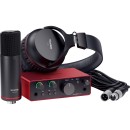
Focusrite Scarlett Solo Studio (4th Generation) |
VS | |
|---|---|---|
| Analog: 2 Inputs / 2 Outputs at 192 kHz |
Channels of I/O |
Analog: 2 Inputs / 2 Outputs at 192 kHz |
| 192 kHz / 24-Bit | Maximum Sampling Rate | 192 kHz / 24-Bit |
| 1 | Number of Microphone Inputs | 2 |
| 1x XLR 3-Pin Balanced Mic Input 1x 1/4" TS Unbalanced Line/Hi-Z Input (Front Panel) 2x 1/4" TRS Balanced Monitor Output 1x 1/4" TRS Headphone Output (Front Panel) |
Analog Audio I/O |
2x XLR 3-Pin Balanced Mic Input 2x 1/4" TRS Balanced/Unbalanced Line/Hi-Z Input (Front Panel) 2x 1/4" TRS Balanced Monitor Output 1x 1/4" TRS Headphone Output (Front Panel) |
| Digital Audio I/O | ||
| 1x USB-C | Host Connection | 1x USB-C |
| macOS Windows |
OS Compatibility |
macOS Windows |
| USB Bus Power, USB Power Adapter (Not Included) | Power Requirements | USB Bus Power, USB Power Adapter (Not Included) |
